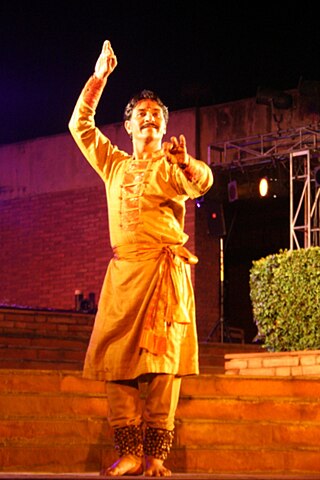Related Research Articles

Medical College, Kolkata, also known as Calcutta Medical College, is a Government medical college and hospital located in Kolkata, West Bengal, India. It is one of the oldest existing hospitals in India. The institute was established on 28 January 1835 by Lord William Bentinck during British Raj as Medical College, Bengal. It is the second oldest medical college to teach Western medicine in Asia after Ecole de Médicine de Pondichéry and the second institute to teach in English language. The college offers MBBS degree after five and a half years of medical training.

The Kakori Train robbery was a train robbery that took place at Kakori, a village near Lucknow, on 9 August 1925, during the Indian independence movement against the British rule in India. It was organized by the Indian revolutionaries of Hindustan Republican Association (HRA).
Saxena is an Indian surname primarily found in northern and Central India. It is a common surname found amongst the Chitraguptavanshi Kayastha community of upper caste Hindus particularly in the Hindi-speaking regions of India. Saxena, in origin, is derived from the Sanskrit word sakhisena meaning “friend of the army”.

Pandit Kumar Bose, born 4 April 1953, is an Indian tabla musician and composer of Indian classical music.
Yaman is a heptatonic (sampurna) Indian classical raga of Kalyan Thaat.
Chetan Joshi is a noted flautist in the Hindustani classical music tradition. He was born in Jharia and brought up at Noamundi and Bokaro Steel City. He was trained under Late Acharya Jagadish (Bokaro), Late Pandit Bholanath Prasanna (Allahabad), Late Pandit Raghunath Seth (Mumbai) and Pandit Ajoy Chakravorty (Kolkata).

Rajendra Gangani is an Indian Kathak dancer known for his innovative style and technical wizardry. Gangani is one of the leading exponents of the Jaipur Gharana style of Kathak. For his contributions to the field of Kathak, Gangani received the Sangeet Natak Akademi Award in 2003 from The President of India A. P. J. Abdul Kalam.
Bhabesh Chandra Sanyal commonly known as B. C. Sanyal, the doyen of modernism in Indian art, was an Indian painter and sculptor and an art teacher to three generations of artists. During his lifetime he not just saw the partition of the Indian subcontinent three times, 1905, 1947 and 1971, but also witnessed 20th century Indian art in all its phases. His notable paintings include The flying scarecrow, Cow herd, Despair and Way to peace, which depicts Mahatma Gandhi with a Hindu and a Muslim child.

Abdul Halim Jaffer Khan was an Indian sitar player. Khan received the national awards Padma Shri (1970) and Padma Bhushan (2006) and was awarded the Sangeet Natak Akademi Award for 1987.

Sharat Chandra Srivastava is a North Indian classical violinist and music composer. He represents the Senia gharana.
Mrigya is an Indian World fusion music band from New Delhi that was formed in 1999. It music is a fusion of Blues, Folk, Funk, Latin, Rock and Jazz along with Indian classical music. Over the years the band has played at national and international music festivals.

Pandit Manilal Nag is an Indian classical sitar player and an exponent of the Bishnupur gharana of Bengal. He was given the Padma Shri Award, the fourth highest civilian award in India in 2020.
Gagan Chandra Chatterjee was a North Indian classical violinist of the Senia Gharana who is known for inventing the gatkari style of North Indian classical violin.
Uttar Pradesh Sangeet Natak Akademi is a key branch of the Uttar Pradesh state government's Department of Culture. Each year the Academy Awards for excellence in performance of music, art and literature are awarded at the Uttar Pradesh Sangeet Natak Akademi.
Seema Bhatnagar is an Indian scientist, working in the field of anticancer drug discovery. She primarily works on synthetic chemistry approaches for targeted delivery of anticancer drugs in breast cancer.

The Dance of the Peacock: An Anthology of English Poetry from India is a 2013 anthology of poems written by one hundred and fifty-one poets; edited by Dr Vivekanand Jha. The one hundred and fifty-one poets include Indians and diasporic Indians.The book was published by Hidden Brook Press, Canada.

Sandeep Ranade is an Indian Classical singer and software engineer from Pune. His composition about coronavirus, "Na Corona Karo," was shared extensively on social media. In 2021, he won an Apple Design Award for his app, NaadSadhana.

Dinesh Kumar Prabhakar is a violinist, composer, conductor and vocalist in Indian Classical Music. He has been behind many pieces of Indian music in the classical, national and religious genres. He has also composed and directed pop music.
References
- ↑ The Oxford Encyclopedia of the Music of India. Oxford University Press. 2011. ISBN 9780195650983.
- ↑ Roychoudhury, Bimalakanta. Bharatiya Sangeet Kosh. Delhi: Vani Prakashan. ISBN 978-93-5000-463-0.
- ↑ "Saarang - the Peacock". Indian Wildlife Club site. Retrieved 13 November 2013.
- ↑ "Traditional tunes". The Telegraph. 15 August 2005. Archived from the original on March 4, 2016. Retrieved 13 November 2013.
- ↑ Narayan, Prakash (1963). Violin Vaadan. Sangeet Kala Sadan.
- ↑ "Pattie Weiss". Ancient Future site. Retrieved 13 November 2013.
- ↑ "Lenneke van Staalen". Indian Music Circle site. Retrieved 13 November 2013.
- ↑ "Sharat Chandra Srivastava" . Retrieved 13 November 2013.